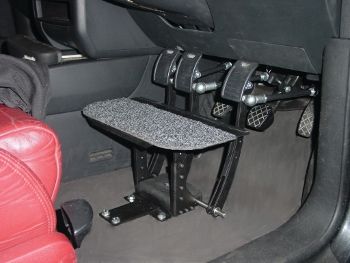Adaptations For The Car
For people of short stature, driving may be difficult, mainly due to rhizomelia. The short limbs make reaching the pedals and the clutch difficult or in some cases, depending on the person's height and limb length, impossible, and seeing over the steering wheel and the sides of the car may also be a challenge.
However, there are adaptations that can be attached to your car and allow for a safer and more comfortable driving. The main adaptation you will need are pedal extenders, which raise the pedals, and sometimes the floor, by up to about 45 cm [1]. The way they're attached to your car may vary: while some are attached directly to the pedals, others are attached to the floor [2, 3]. The latter sometimes have raised floors [4].


|
Pedal Extenders. Credits to: rica.org.uk |
Unfortunately pedal extenders with raised floors are harder to find and may not be available everywhere since the raised floor is optional, not a necessity. It allows you to rest your feet while not accelerating, breaking or using the transmission and avoiding hovering your feet over the pedals, which can be tiring. Pedal extenders can typically be detached to allow for a person of average height to drive the car (for instance when it needs repairs).
You can also opt for exclusively manual controls and learn how to drive only using your hands. This may be a better option if there's no driving school with pedal extenders available in your area and you can't learn using your own car. It is also easier to find these adaptations in workshops.
You can find these adaptations in some (but not all) car conversion shops, but they will have to abide to your country's laws and be approved by the government in some countries, since they need to be properly secured and of the appropriate height.
You may also want a thick cushion for your back and another one on the seat, so you can reach the full range of movement of the driving wheel and clutch. However, make sure that these cushions are properly attached to the seat [1, 3].
It is recommended that you turn off your airbags, since there's a certain distance (25 cm from the breast bone to the steering wheel) that must be maintained in order to avoid airbag related injury. If the length of your limbs does not allow for this distance to be maintained, you should turn off your car's airbags [5, 6].


|
Example of manual controls in a car (ball and lever). Credits: Zezin Adaptações. |
It is also possible that a car with an automatic transmission may be more adequate, since reaching the gear stick may not always be easy due to reduced reach. Each person has different needs, and you should try different cars in order to choose an adequate model for your particular situation.
Sources
- Secor, C. ADAPTATIONS – DRIVING. [cited 2017 15/09].
- Drive Master. Pedal Extensions. 2017 [cited 2017 15/09].
- .Secor, C. Portable Pedal Extenders. 2017 [cited 2017 15/09].
- Auto Adapt. Driving aids for successful driving. 2008 [cited 2017 15/09].
- National Highway Trafic Safety Administration. Air Bags and On-Off Switches: Information For an Informed Decision. [cited 2017 15/09].
- Segui-Gomez , M., J. Levy , and J.D. Graham Airbag Safety and the Distance of the Driver from the Steering Wheel. New England Journal of Medicine, 1998. 339(2): p. 132-133.


